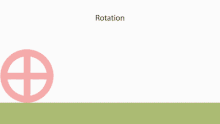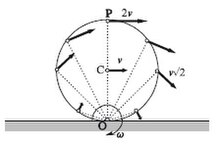roll

The rollers is a movement art round body - in particular wheels - in which the types of motion rotation and displacement are combined in a particular manner. A circular body that moves in a straight line on a flat surface rolls exactly when the center covers a distance during one revolution that corresponds to its circumference . If the path is shorter, then there is slip . In the case of bikes, one speaks of spinning if the path is zero. When the path is greater , the body slides . This is the case, for example, when braking vehicles when the wheels lock. The following describes slip-free rolling.
The point of contact, i.e. the point at which the body touches the ground, moves during one revolution of the body along a path whose length corresponds to the circumference of the body. The body does not have to be circular, it can also be elliptical, for example. The distance is measured along the distance covered, i.e. not along a straight route. In the case of slip-free rolling movements, the point of contact is always the instantaneous pole . Mathematically, the roll condition applies , which indicates a relationship between the angle (in radians ) by which the body rotates in a certain period of time, the radius of the body and the distance covered .
Rolling doesn't just occur with wheels. The balls in a ball bearing also roll in the rings, the pulleys in pulleys roll in relation to the ropes, just like a yo-yo in relation to the cord. The physical requirement for rolling is static friction between the rolling body and the base. Without friction, the body would only slide without turning. The acceleration of rolling bodies depends not only on their mass, as in the case of purely translational movement, but also on the moment of inertia . Two cylinders that roll down an inclined plane experience different acceleration if they have the same masses and outer radii, but have different mass distributions, for example in the case of a solid aluminum cylinder and a hollow steel cylinder of the same size, see wheel rolling down an inclined plane . This is an important difference to free fall , in which the acceleration is independent of the mass. Work has to be done for both the linear and the rotating movement. In the case of rolling bodies, these are in a fixed relationship to one another.
Examples of rolling movements
The rolling motion of vehicle wheels, such as occurs on bicycles or cars, is particularly well known . Here, almost circular bodies roll on a mostly flat surface. The same also applies to bottles rolling on the floor or wine glasses rolling on a table, for example if they are knocked over. On an inclined plane , balls or cylinders roll down under the action of gravity alone. This occurs mainly in experiments. Galileo, for example, used them to study the laws of motion . The movement of the rollers in a pulley block can be understood as a rolling movement in which the rollers roll on the rope. The same applies to the movement of a yo-yo that performs a rolling movement with respect to the string on which it is attached. It also occurs in some machines: the balls in a ball bearing roll on both the inner and the outer ring. The same applies to all other rolling bearings . Several gears move in a planetary gear . In one of the possible operating modes, the middle wheel - the sun wheel - and the other wheels - the planetary gears - roll around it. There is also a rolling movement in the case of two gear wheels with fixed axes. One of the two gears can be thought of as being stationary, the other then rolling on the circumference, similar to a planetary gear. With some types of gearing, the individual, touching teeth roll off one another, which is known as a rolling movement .
Requirements and conditions for rolling
The prerequisite for the rolling movement is static friction between the rolling body and the ground. If there is no friction, the body rotates in place if only a torque acts on the wheel, or it is displaced without rotation if only a force acts on its center of gravity. The first case can be seen more or less when approaching cars on a mirror-like surface of ice. The adhesive force is caused by a force that is perpendicular to the substrate: the normal force . In the case of a horizontal base, the normal force corresponds to the weight force, provided no other forces are acting. In sports cars, the contact pressure is increased by spoilers , which also increases the grip between the wheel and the road. At the point of contact between the body and the ground, there is no relative movement when rolling , which causes static friction. If the driving force in vehicles is too great, sliding friction occurs instead of static friction and the wheel spins.
The resistance of the entire wheel to the rolling movement is caused by the rolling friction . This is already caused by minimal deformation of the wheel due to the contact pressure on the ground and by deformation of the ground. Without this contact force, the rolling friction disappears, but also the static friction, so that the body can no longer roll. If a perfectly circular wheel is pressed onto a surface that is absolutely flat, then theoretically a pressure arises at the point of contact that deforms every real body. The phenomenon is known as Hertzian pressure and is particularly important in the case of rigid bodies that only deform slightly, such as train wheels or the balls of a ball bearing. The tires of cars and bicycles are usually filled with air and deform more strongly, so that there is a pronounced contact surface, the tire contact . In the case of a car, its area roughly corresponds to that of a postcard. These wheels then do not roll on a radius that corresponds to their undeformed outer radius. The distance between the wheel center and the road surface is the static radius (static radius) of the wheel. A point on the surface of the car tire then initially moves on a radius that corresponds to the undeformed radius until it hits the road. Then the radius gradually decreases to the static radius. The rolling of a car wheel can, however, also be described as a model with the movement of a rigid body. It should apply to this that it covers a distance during one revolution which corresponds to its radius. The radius of the undeformed wheel is too large, the static radius too small. Instead, the experimentally determined dynamic radius is used.
Kinematics of the rolling movement
The kinematics is a part of mechanics, only with the sizes time , location, speed and acceleration is concerned. Forces, masses and quantities derived from them, such as energy and power, are not taken into account.
Rolling is a combination of the turning movement ( rotation ) and the straight movement ( translation ). When rolling, the two are combined in a certain way: the rolling body covers a path during one revolution that corresponds to its circumference. In addition, the rolling body has no speed relative to it at the points where it touches the ground. A point on a wheel touches down on the road at a certain point in time and then takes off again without sliding or dragging across the road in between. A top whose axis is perpendicular to the ground does not roll even if it is shifted around the circumference during one revolution, because the point of contact has a speed relative to the ground. The axis of rotation must not be perpendicular to the base. In addition, there has to be any contact between the rolling body and the ground. For example, if a bicycle is upside down on the handlebars and saddle, as is customary when changing a wheel, the (rear or front) wheel will not roll even if it covers a suitable path during one rotation, for example by moving the entire bicycle at the same time. It doesn't roll on the ground.
Suitable reference and coordinate systems
The rolling movement can be described in a reference system in which the environment is stationary and only the rolling body moves. It is also possible to view the rolling body as motionless. But then the entire environment moves. It makes sense to split the rolling movement into two components, rotation and displacement.
- The displacement of the center of the body is described in a reference system that is at rest in relation to the environment. The commonly used coordinate system with xy coordinates is suitable for the description ( Cartesian coordinate system , in space xyz coordinates)
- The rotation of any point around the center is described in a reference system, the origin of which is at the center of the body at any point in time. So it moves with the body. Polar coordinates are used for description in the plane . (In space spherical or cylindrical coordinates )
Rolls in one plane
The simplest form of rolling motion occurs when a wheel with a constant radius is always upright on a level surface and only moves in a straight line, for example when riding a bicycle in a straight line. The wheel then moves in one plane. Mathematically, it can be described as movement in the xy plane .
position
The position of a wheel that rolls on the x-axis can be specified in two different ways:
- By specifying the coordinate of the center point or the point of contact.
- By specifying an angle (small, Greek phi ) that indicates the number of revolutions. In this case, the angle can also be greater than 360 °. With two full revolutions it is, for example, 2 × 360 ° = 720 °. It can also turn negative.
One of the two entries is sufficient because the other can be calculated if the radius of the wheel is known. The roll condition applies :
- .
If the center point continues to move around the path , then the wheel continues to turn around the angle . The following applies:
A body that rolls within a plane therefore has exactly one degree of freedom . Rotation and translation are not independent of each other. However, it is often useful to use both information at the same time.
Speed and acceleration of the center
The change in the location of the center point in a certain time interval corresponds to the speed . The change in the angle in the same time interval corresponds to the angular velocity (small, Greek omega ). The following applies:
- .
Instead of the angular velocity, the rotational speed can also be used, which indicates the number of revolutions in a period of time. The following applies:
The change in the speed of the center point in a certain time interval corresponds to the acceleration and the change in the angular speed in the same time interval corresponds to the angular acceleration . The following applies:
- .
Speed of any point
With a rolling body, each point of the body has a different speed and acceleration in relation to the ground. This affects both the amount and the direction of both quantities. On a bicycle, for example, the foremost point of the wheel moves obliquely downwards and the rearmost point moves obliquely upwards, see picture. The magnitude of their velocities, however, corresponds to √2 times the center point, because the diagonal in a square is √2 times the length of the sides. The lowest point of the wheel where it touches the road has zero speed with respect to the road, and the top point moves forward at twice the center point speed.
The amount of the speeds depends on the reference system: If the origin of the coordinate system is in the center of the wheel and moves with it, but does not rotate, then the rolling movement appears like a pure rotation around the origin and every point on the circumference of the wheel same speed:
Roll on one level
Experience has shown that you can not only ride a bicycle back and forth in a straight line, but also reach any location on the surface of the earth using suitable steering maneuvers. The position of the contact point is usually described in a Cartesian coordinate system with the x and y coordinates. In addition, three angles must be specified:
- An angle that indicates how far the body has rotated around its axis. In the case of a bicycle tire, for example, the position of the valve can be specified.
- An angle that indicates the direction in which the axis of the body is pointing. For example, the position of the handlebars on a bicycle.
- An angle that indicates the position of the axis to the ground. When cycling in a straight direction, it runs parallel to the ground. When cornering, however, the driver leans into the curve and the angle changes.
See also
- Gyroscopic Effect - explains why rolling coins won't fall over
- Epicycloids - geometric figures created by rolling circles on larger circles
Individual evidence
- ↑ Wolfgang Nolting: Basic Course Theoretical Mechanics 1 - Classical Mechanics , Springer, 10th edition, 2013, p. 307. 332.
- ^ Honerkamp, Römer: Classical Theoretical Physics , Springer, 4th edition, 2012, p. 62.
- ↑ Müller-slany: Tasks for Technical Mechanics , Springer, 2015, p. 250.
- ↑ Müller-slany: Tasks for Technical Mechanics , Springer, 2015, p. 203.
- ^ Gross, Hauger, Wall: Technische Mechanik 3 - Kinetik , Springer, 13th edition, p. 282 f.
- ↑ Dankert, Dankert: Technische Mechanik , Springer, 7th edition, 2013, pp. 465, 573 f., 570.
- ↑ Dankert, Dankert: Technische Mechanik , Springer, 7th edition, 2013, p. 294.
- ↑ Breuer, Rohrbach-Kerl: Fahrzeugdynamik , Springer, 2015, p. 7 f.
- ↑ Wolfgang Nolting: Basic Course Theoretical Mechanics 2 - Analytical Mechanics , Springer, 9th edition, 2014, p. 12, 47.






















